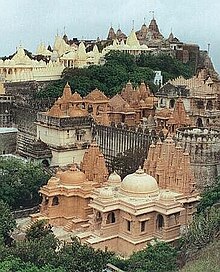Jain art

The Jain Art is a branch of Indian art and architecture . Buildings and sculptures were and are donated by the often wealthy members of the Jain religion ; however, the craftsmen and artists who carried out the work were mostly Hindus , as the Jainas themselves usually do not do any physical work and are mainly traders to this day. Many traditional Jain shrines are located on mountain tops, but there are also one or more Jain temples in every major city in India .
history
Jaina art seems to have arisen at about the same time as Buddhist art - possibly the oldest work of art dates back to the 3rd century BC. And is in the Museum of Patna ( Bihar ). Possibly the 2nd century BC Further bronze figurines can be added to the BC . The treasures found in Chausa (Bihar) and Akota ( Gujarat ) also contain exclusively Jain bronzes. In the Gupta period (approx. 320-550 AD) mainly Hinduism was promoted and so Jainism only experienced its heyday in the Indian High Middle Ages . During the time of the Islamic advance in northern India , many temples were destroyed, but in contrast to the Hindu temples, most of the Jaina places of worship were later rebuilt.
architecture
sculpture



In addition to the architecture, the sculptural achievements of Jain art are impressive, which - if not in the variety of subjects, at least in the delicacy of the execution - even surpass the contemporary works of the Hindus. The marble often used also plays an important role here, making extremely fine depictions possible. The best examples are the sculptures in the Dilwara temples at Mount Abu and at the Adinath temple at Ranakpur . Basically, it can be stated that the visual art of the Jainas has a highly static character - narrative picture reliefs such as can be found everywhere in early Buddhist or Hindu art are completely absent. Likewise, there is usually no natural or landscape background, as this could distract from concentrating on the essentials. Immobility and non-violence ( ahimsa ) as well as detachment from everything earthly are not only theoretical goals of the Jaina philosophy, but are also conveyed through art. Only the accompanying figures of the Tirthankaras , which appear rarely, are sometimes shown in motion or in action.
At first glance, the Jaina tirthankaras depicted in the lotus position or standing do not differ much from the portraits of Buddha , but they are relatively easy to distinguish from them due to their complete nudity and mostly wide-open eyes. Further distinguishing features are a breast jewel - which appeared in later times - and the frequent lack of a hair knot ( ushnisha ), which is typical for Buddha. In addition, Jaina art knows no differentiated hand postures ( mudras ) - with standing figures, the arms hang down to the sides of the body, but do not touch it ( kayotsarga ), with seated figures the hands are in a kind of meditation gesture ( dhyanamudra ) with upward pointing Palms interlocked. Both in a sitting and in a standing position, the Jaina figures convey an image of meditative, worldly equilibrium and calm while still being awake, as indicated by the wide-open eyes.
Iconographically - with a few exceptions (e.g. Parshvanata or Bahubali / Gomteshvara) - the 24 Tirthanharas can only be identified by added attributes, i.e. H. usually differ from each other by animals located below their throne seats. The accompanying figures ( yakshas , nagas , elephants, etc.) are usually shown in small format and are borrowed from Buddhist or Hindu art.
painting


One can hardly speak of Jainist painting, although figurative and ornamental paintings are already known from medieval palm leaf manuscripts or from the Shāntinātha Charitra , the biography of the Tirthankara Shantinatha , written in 1397, and in several Jaina caves (e.g. Ellora ( Maharashtra ), Sittanavasal and Tirumalai (both Tamil Nadu )) can still be seen today, but only contain a few narrative themes. Stylistically, they do not differ significantly from Buddhist paintings (e.g. in Ajanta ) or from simple village paintings. The large-scale paintings in the temple complex of Achalgarh (near Mount Abu), in which individual legends of the respective Tirthankaras are depicted, date from the 19th and 20th centuries . The same applies to the Jain temple of Sarnath (near Varanasi ) as well as to other modern temples, which are mostly located in the larger cities.

Important sites
|
Rajasthan |
North and Central India
|
South india
|
literature
- Sehdev Kumar: Jain Temples of Rajasthan . Abhinav Publications, New Delhi 2001, ISBN 978-81-7017-348-9
- Jose Pereira: Monolithic Jinas . Motilal Banarsidass Publ., New Delhi 1977, ISBN 978-81-208-2397-6

